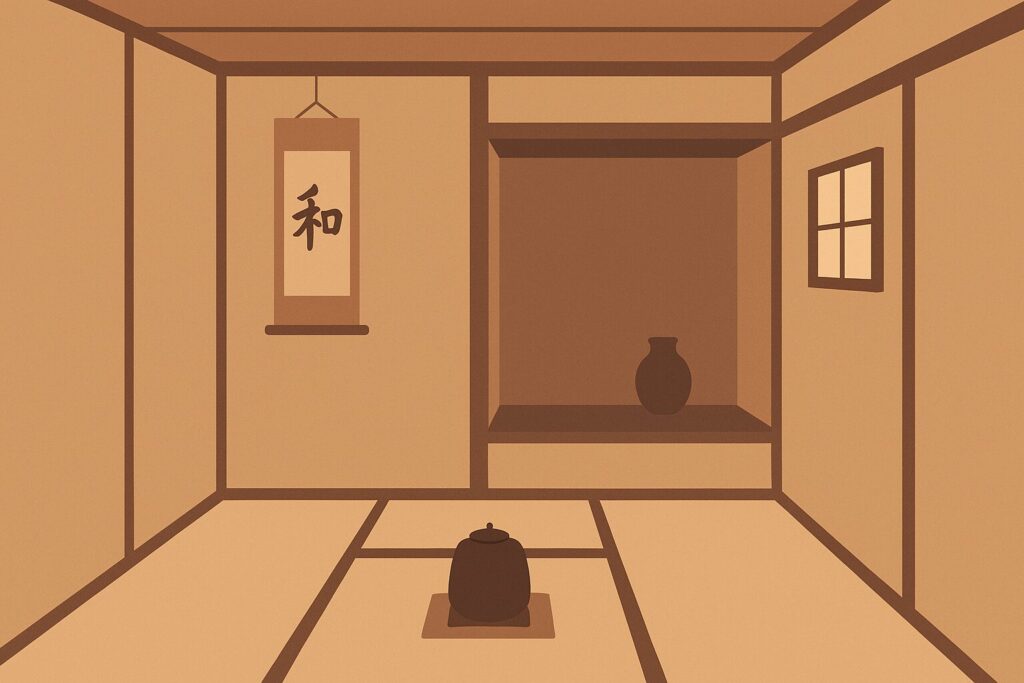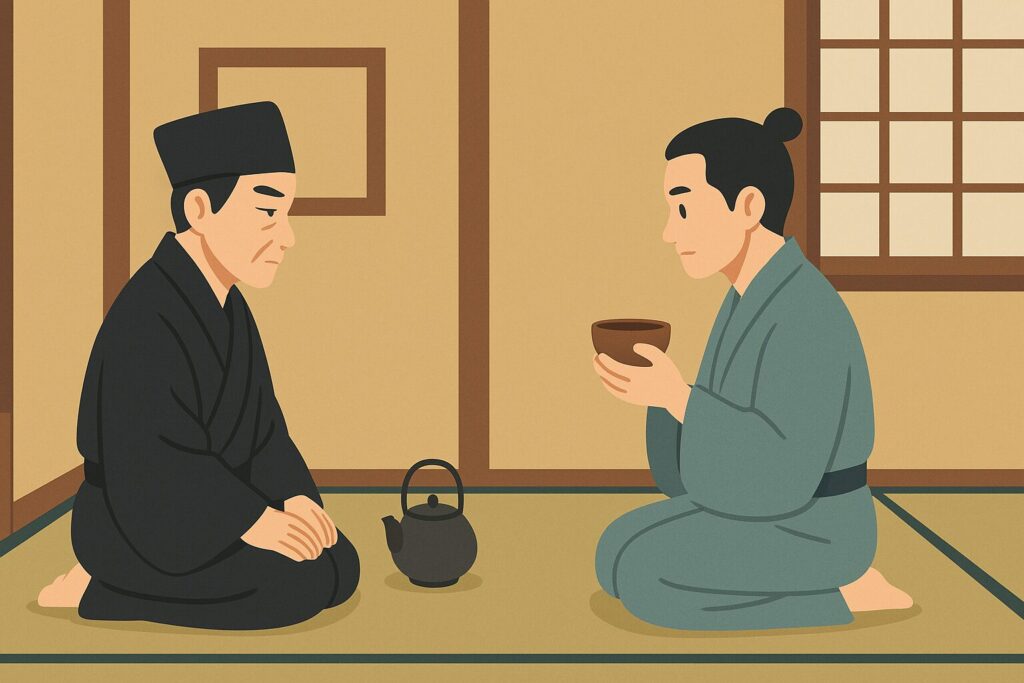千利休を英語で説明・紹介するための基本情報と、英会話に役立つ表現をシンプルでわかりやすい英語で紹介します。
英会話ダイアローグ・概要・10の質問を通して、千利休に関する英語表現を学びます。
英語
英会話ダイアローグを読む前に知っておくと良い前提知識と情報です。
- 千利休の基本情報
- 16世紀(戦国時代〜安土桃山時代)に活躍した茶人
- 茶道の中でも「侘び茶」という様式を完成させた
- 質素・静寂・精神性を重視した茶の湯を広めた
- 織田信長、豊臣秀吉などの有力な武将に仕えたが、晩年は秀吉と対立し、切腹を命じられた
- 茶道の哲学
- 「侘び茶」:豪華な茶会とは違い、素朴さ・不完全さ・自然の美を大切にする茶の湯のスタイル
- 「わび・さび」:飾り立てない素朴さ、不完全さ、自然の美を尊ぶ美学
- 「和敬清寂」:和やかさ、敬意、清らかさ、静けさを重んじる茶道の精神
- 千利休の茶道の特徴
- 豪華な装飾より簡素さを重視
- 自然素材や古い道具に美を見出す美意識
- 小さな茶室での親密な茶会を理想とした
- 楽焼などの素朴な茶碗や竹製の茶杓を好んだ
- 逸話と伝承
- 「朝顔の逸話」:秀吉の来訪時、一輪だけ残して他をすべて切り落とした話
- 「刀を置く」:茶室では身分の区別なく皆平等とする考え方
- 千利休の遺産
- 「待庵(たいあん)」:国宝に指定された利休設計の茶室
- 「三千家」:利休の教えは、表千家・裏千家・武者小路千家という三大流派を通じて現代にも受け継がれている
2人が千利休について語しています。
千利休の哲学や功績、侘び茶の特徴、簡素さを重んじる精神、茶室での平等の考え方、朝顔の逸話、豊臣秀吉との確執などを話題にしています。
会話 / dialogue

Hey Key, do you have a minute? I’ve been reading about Sen no Rikyu, and I’m fascinated. I didn’t know the tea ceremony had such deep meaning.

Really? That’s cool. Rikyu is a pretty big name in Japanese culture. What got you interested?

Well, I visited a tea house in Kyoto last month, and the host mentioned Rikyu. He said Rikyu changed the way tea was seen in Japan. That made me curious.

He absolutely did. Before Rikyu, tea gatherings were more about showing off wealth. But Rikyu made it all about simplicity and spirit.

Right, like the idea of “wabi-cha,” right? I read that it means finding beauty in simple, natural things.

Exactly. He believed even an old, cracked tea bowl could be more beautiful than a shiny, perfect one.

That’s really different from Western ideas of beauty. I like how deep it is.

Yeah, and he also designed tea rooms that were really small—just enough for a few people. It was all about quietness and mindfulness.

I saw a photo of his tea room, “Tai-an.” It looked tiny, but peaceful.

That’s the one! And did you hear about the story with the morning glory flower?

No, what happened?

When Toyotomi Hideyoshi came for tea, Rikyu cut down all the morning glories in his garden—except for one. He put that single flower in the tea room. Hideyoshi was really impressed.

Wow… that’s powerful. One flower says more than a hundred.

That’s Rikyu’s style—minimal but meaningful.

And I heard he once asked a samurai to remove his sword before entering?

Yes! He told the samurai, “In the tea room, everyone is equal.” That was a bold move at that time.

So he wasn’t just about tea. He had strong beliefs about respect and peace.

Definitely. Even though he worked for powerful leaders, he stayed true to his values. That’s why he’s still respected today.

But didn’t he die in a tragic way?

Yeah, unfortunately. He and Hideyoshi had some conflicts. One big issue was a statue of Rikyu placed at a temple gate—some say it made Hideyoshi angry.

Did Rikyu put the statue there himself?

Most historians think he didn’t. It was probably his students. But Hideyoshi saw it as disrespectful.

That’s sad. Still, his legacy lives on, right?

Yes, his spirit is still alive in modern tea schools like Urasenke. People all over the world learn his way.

I really want to try a proper tea ceremony now—one that follows Rikyu’s ideas.
概要(千利休とは?侘び茶を完成させた茶人の基本解説)
「千利休」について、理解を深めるための「英語での概要」です。
千利休

Who Was Sen no Rikyu?
Sen no Rikyu was a famous tea master in Japan. He lived from 1522 to 1591. Rikyu changed the way people thought about the tea ceremony. He taught that tea is not just a drink. It is a way to find peace, respect, and beauty in everyday life.
The Idea of Wabi-cha
Rikyu created a new style of tea called wabi-cha. It is simple and calm. He believed that old, natural things can be more beautiful than perfect, shiny ones. For example, he liked tea bowls with small cracks or made by hand. He thought true beauty comes from nature and from the heart.
The Tea Room and Tools
Rikyu also designed tea rooms. His rooms were very small and quiet, usually for only two or three people. This helped people focus and relax. The entrance to the tea room was low, so everyone had to bow. This showed that all people were equal, even samurai or lords.
Famous Stories
One famous story is about a flower. When a powerful man came to visit, Rikyu cut all the flowers in his garden. He left only one in the tea room. This simple act showed great beauty and care. Another story tells how Rikyu asked a samurai to remove his sword. In the tea room, there is no rank.
Rikyu’s Legacy
Rikyu died in 1591, but his ideas still live on. Many tea schools in Japan, like Urasenke, follow his way. Today, people around the world learn the tea ceremony and Rikyu’s peaceful spirit.
10の質問(千利休を知るための基本Q&A)
「千利休」について、理解を深めるための「英語での10の質問」です。
1: Who was Sen no Rikyu?
Sen no Rikyu was a famous tea master in Japan. He lived from 1522 to 1591 and changed the way people practiced the tea ceremony.
2: What is wabi-cha?
Wabi-cha is a simple and calm style of tea that Rikyu developed. It focuses on natural beauty, peace, and the heart of the host and guest.
3: Why is Rikyu important in Japanese culture?
Rikyu made the tea ceremony more spiritual and less about showing wealth. His ideas still influence Japanese tea culture today.
4: What kind of tea room did Rikyu design?
Rikyu designed small and quiet tea rooms. They usually had space for only a few people to help them focus and relax.
5: What is the meaning of the low entrance to the tea room?
The low entrance made everyone bow when entering. This showed that everyone is equal, no matter their status.
6: What did Rikyu think about beauty?
Rikyu believed that true beauty is in simple and imperfect things. He liked old, handmade tea bowls with cracks.
7: What is a famous story about Rikyu and a flower?
When a powerful man visited, Rikyu cut all the flowers in his garden and placed only one in the tea room. This showed beauty through simplicity.
8: What did Rikyu say to a samurai about his sword?
Rikyu told a samurai to remove his sword before entering the tea room. He said that in the tea room, all people are equal.
9: Why did Rikyu die?
Rikyu had conflicts with Toyotomi Hideyoshi, a powerful leader. One reason was a statue of Rikyu placed at a temple gate, which made Hideyoshi angry.
10: How is Rikyu remembered today?
Rikyu is still respected today. Tea schools like Urasenke follow his teachings, and people around the world learn from his way of tea.

和訳付
会話 / dialogue

Hey Key, do you have a minute? I’ve been reading about Sen no Rikyu, and I’m fascinated. I didn’t know the tea ceremony had such deep meaning.
ねえキー、ちょっといい?千利休について読んでたんだけど、すごく興味深くてさ。茶道にこんなに深い意味があるなんて知らなかったよ。

Really? That’s cool. Rikyu is a pretty big name in Japanese culture. What got you interested?
そうなんだ?いいね。利休って、日本文化ではかなり有名な存在だよ。どうして興味を持ったの?

Well, I visited a tea house in Kyoto last month, and the host mentioned Rikyu. He said Rikyu changed the way tea was seen in Japan. That made me curious.
先月、京都で茶室を訪れたんだ。そこの亭主が利休の話をしてくれて、日本の茶の見方を変えた人だって言ってた。それで気になって。

He absolutely did. Before Rikyu, tea gatherings were more about showing off wealth. But Rikyu made it all about simplicity and spirit.
確かにそうだよ。それまでの茶会って、お金持ちぶりを見せるような場だったけど、利休は「質素さ」と「心」を大事にしたんだ。

Right, like the idea of “wabi-cha,” right? I read that it means finding beauty in simple, natural things.
だよね、“侘び茶”ってやつでしょ?シンプルで自然なものに美を見いだすって読んだよ。

Exactly. He believed even an old, cracked tea bowl could be more beautiful than a shiny, perfect one.
そうそう。古くてヒビの入った茶碗の方が、ピカピカの完璧なものより美しいこともあるって思ってたんだ。

That’s really different from Western ideas of beauty. I like how deep it is.
それって西洋の美の考え方とは全然違うよね。そういう深さ、すごく好きだな。

Yeah, and he also designed tea rooms that were really small—just enough for a few people. It was all about quietness and mindfulness.
うん、それに利休は茶室もすごく小さく設計してて、少人数しか入れないくらいだったよ。静けさと心の集中が大事だったんだ。

I saw a photo of his tea room, “Tai-an.” It looked tiny, but peaceful.
“待庵”っていう茶室の写真を見たよ。すごく小さかったけど、なんか落ち着いてていい雰囲気だった。

That’s the one! And did you hear about the story with the morning glory flower?
それそれ!で、朝顔の話って知ってる?

No, what happened?
ううん、知らない。何があったの?

When Toyotomi Hideyoshi came for tea, Rikyu cut down all the morning glories in his garden—except for one. He put that single flower in the tea room. Hideyoshi was really impressed.
秀吉が茶会に来るとき、利休は庭の朝顔を全部切って、たった一輪だけ茶室に飾ったんだって。その一輪がすごく印象的だったらしくて、秀吉も感動したんだ。

Wow… that’s powerful. One flower says more than a hundred.
うわぁ… それってすごいね。一輪の花で百の花以上のことを伝えるって感じだ。

That’s Rikyu’s style—minimal but meaningful.
それが利休のスタイルだよ。最小限だけど、ちゃんと意味があるんだ。

And I heard he once asked a samurai to remove his sword before entering?
それから、武士に刀を外すように言ったことがあるって聞いたんだけど?

Yes! He told the samurai, “In the tea room, everyone is equal.” That was a bold move at that time.
そうだよ!「茶室ではみんな平等です」って。その時代にそれを言うのって、すごく勇気があることだったんだ。

So he wasn’t just about tea. He had strong beliefs about respect and peace.
じゃあ、彼はただの茶人じゃなかったんだね。敬意とか平和に対して強い信念があったんだ。

Definitely. Even though he worked for powerful leaders, he stayed true to his values. That’s why he’s still respected today.
うん、間違いない。あれだけの権力者に仕えてても、自分の信念を曲げなかったから、今でも尊敬されてるんだよ。

But didn’t he die in a tragic way?
でも、最後は悲しい結末だったんだよね?

Yeah, unfortunately. He and Hideyoshi had some conflicts. One big issue was a statue of Rikyu placed at a temple gate—some say it made Hideyoshi angry.
うん、残念ながら。利休と秀吉の間にはいろいろあってさ。その一つが、お寺の門に利休の像が置かれたこと。それが秀吉の怒りを買ったって言われてる。

Did Rikyu put the statue there himself?
その像って、利休が自分で置いたの?

Most historians think he didn’t. It was probably his students. But Hideyoshi saw it as disrespectful.
多くの歴史家は、利休本人じゃないって考えてるよ。たぶん弟子たちがやったんだろうね。でも、秀吉はそれを無礼と受け取ったんだ。

That’s sad. Still, his legacy lives on, right?
それは悲しいね。でも、彼の遺産は今も生きてるんだよね?

Yes, his spirit is still alive in modern tea schools like Urasenke. People all over the world learn his way.
うん、今でも裏千家みたいな茶道の流派に彼の精神は受け継がれてるし、世界中の人たちが彼の教えを学んでるよ。

I really want to try a proper tea ceremony now—one that follows Rikyu’s ideas.
今度はちゃんと利休の思想に基づいた茶会を体験してみたいな。
概要(千利休とは?侘び茶を完成させた茶人の基本解説)
千利休

Who Was Sen no Rikyu?
Sen no Rikyu was a famous tea master in Japan. He lived from 1522 to 1591. Rikyu changed the way people thought about the tea ceremony. He taught that tea is not just a drink. It is a way to find peace, respect, and beauty in everyday life.
千利休は、日本で有名な茶人でした。彼は1522年から1591年まで生きました。利休は、人々の茶道に対する考え方を変えました。お茶はただの飲み物ではなく、日常の中に平和や敬意、美しさを見つける方法だと教えました。
The Idea of Wabi-cha
Rikyu created a new style of tea called wabi-cha. It is simple and calm. He believed that old, natural things can be more beautiful than perfect, shiny ones. For example, he liked tea bowls with small cracks or made by hand. He thought true beauty comes from nature and from the heart.
利休は「侘び茶」と呼ばれる新しいスタイルの茶を作りました。それはシンプルで静かなものです。彼は、完璧でピカピカのものよりも、古くて自然なものの方が美しいと考えていました。たとえば、手作りでひびの入った茶碗を好みました。真の美しさは自然や心から生まれると信じていたのです。
The Tea Room and Tools
Rikyu also designed tea rooms. His rooms were very small and quiet, usually for only two or three people. This helped people focus and relax. The entrance to the tea room was low, so everyone had to bow. This showed that all people were equal, even samurai or lords.
利休は茶室も設計しました。彼の茶室はとても小さく静かで、ふつうは2〜3人しか入れませんでした。これによって、人々は集中し、リラックスすることができました。茶室の入り口は低く作られており、誰もが頭を下げて入らなければなりませんでした。これは、武士や貴族であっても、すべての人が平等であることを表していました。
Famous Stories
One famous story is about a flower. When a powerful man came to visit, Rikyu cut all the flowers in his garden. He left only one in the tea room. This simple act showed great beauty and care. Another story tells how Rikyu asked a samurai to remove his sword. In the tea room, there is no rank.
有名な話の一つは花に関するものです。ある権力者が訪ねてきたとき、利休は庭の花をすべて切り取り、茶室にたった一輪だけ残しました。このシンプルな行動が、深い美しさと思いやりを表しました。別の話では、利休が武士に「刀を外してから入ってください」と言ったとされています。茶室では身分の差はないのです。
Rikyu’s Legacy
Rikyu died in 1591, but his ideas still live on. Many tea schools in Japan, like Urasenke, follow his way. Today, people around the world learn the tea ceremony and Rikyu’s peaceful spirit.
利休は1591年に亡くなりましたが、彼の考えは今も生き続けています。日本には裏千家のように、利休の流れを受け継いでいる多くの茶道の流派があります。現在では、世界中の人々が茶道や利休の平和な精神を学んでいます。
10の質問 (千利休を知るための基本Q&A)
1: Who was Sen no Rikyu?
千利休とは誰ですか?
Sen no Rikyu was a famous tea master in Japan. He lived from 1522 to 1591 and changed the way people practiced the tea ceremony.
千利休は日本の有名な茶人です。1522年から1591年まで生き、茶道のあり方を変えた人物です。
2: What is wabi-cha?
侘び茶とは何ですか?
Wabi-cha is a simple and calm style of tea that Rikyu developed. It focuses on natural beauty, peace, and the heart of the host and guest.
侘び茶は利休が作り上げた、シンプルで静かな茶のスタイルです。自然の美しさ、心の平穏、そして亭主と客の心の交流を大切にします。
3: Why is Rikyu important in Japanese culture?
なぜ利休は日本文化において重要なのですか?
Rikyu made the tea ceremony more spiritual and less about showing wealth. His ideas still influence Japanese tea culture today.
利休は茶道を精神的なものにし、富を見せびらかすものではなくしました。彼の思想は今でも日本の茶文化に影響を与えています。
4: What kind of tea room did Rikyu design?
利休はどのような茶室を設計したのですか?
Rikyu designed small and quiet tea rooms. They usually had space for only a few people to help them focus and relax.
利休は小さく静かな茶室を設計しました。少人数だけが入れる空間で、集中しやすく、落ち着けるようになっています。
5: What is the meaning of the low entrance to the tea room?
茶室の低い入口にはどんな意味がありますか?
The low entrance made everyone bow when entering. This showed that all people are equal, no matter their status.
低い入口は、誰もが頭を下げて入るようになっています。これは、身分に関係なくすべての人が平等であることを表しています。
6: What did Rikyu think about beauty?
利休は美しさについてどう考えていましたか?
Rikyu believed that true beauty is in simple and imperfect things. He liked old, handmade tea bowls with cracks.
利休は、本当の美しさはシンプルで不完全なものにあると考えていました。彼は、ひびの入った古い手作りの茶碗を好みました。
7: What is a famous story about Rikyu and a flower?
利休と花にまつわる有名な話は何ですか?
When a powerful man visited, Rikyu cut all the flowers in his garden and placed only one in the tea room. This showed beauty through simplicity.
ある権力者が訪ねてきたとき、利休は庭の花をすべて切り取り、茶室に一輪だけ飾りました。この行動は、シンプルさの中にある美を示しました。
8: What did Rikyu say to a samurai about his sword?
利休は武士に刀について何と言ったのですか?
Rikyu told a samurai to remove his sword before entering the tea room. He said that in the tea room, all people are equal.
利休は、茶室に入る前に刀を外すよう武士に言いました。茶室の中ではすべての人が平等だと伝えたのです。
9: Why did Rikyu die?
利休はなぜ亡くなったのですか?
Rikyu had conflicts with Toyotomi Hideyoshi, a powerful leader. One reason was a statue of Rikyu placed at a temple gate, which made Hideyoshi angry.
利休は、権力者の豊臣秀吉との間に対立がありました。その理由のひとつは、寺の門に利休の像が置かれたことで、秀吉の怒りを買ったとされています。
10: How is Rikyu remembered today?
今日、利休はどのように記憶されていますか?
Rikyu is still respected today. Tea schools like Urasenke follow his teachings, and people around the world learn from his way of tea.
利休は今でも尊敬されています。裏千家のような茶道の流派が彼の教えを受け継ぎ、世界中の人々が彼の茶の道から学んでいます。

words & phrases
英会話ダイアローグと関連情報に出てきた単語・フレーズです(例文は各3つ)。

cracked : 形容詞
意味:ひびの入った、壊れた。/ Something that is broken with small lines on the surface, but not completely split.
(利休が美しさを感じた「完璧ではない茶碗」の例として使用)
例文:
- He used a cracked tea bowl in the ceremony.
「彼は茶会でひびの入った茶碗を使いました。」 - The wall was old and cracked.
「その壁は古くてひびが入っていました。」 - I dropped my phone, and now the screen is cracked.
「携帯を落としてしまって、画面にひびが入りました。」
shiny : 形容詞
意味:つやのある、光沢のある。/ Something that reflects light and looks bright and polished.
(利休が好まなかった「完璧で光沢のある茶道具」の対比として使用)
例文:
- He preferred a simple bowl to a shiny one.
「彼はピカピカのものよりも、素朴な茶碗を好みました。」 - The car was clean and shiny.
「その車はピカピカで綺麗でした。」 - She wore shiny shoes to the party.
「彼女はパーティーに光沢のある靴を履いていきました。」
mindfulness : 名詞
意味:心を今この瞬間に集中させること。注意深さ。/ The practice of focusing your attention on the present moment in a calm and thoughtful way.
(利休が設計した小さな茶室での「集中」と「静寂」の価値を表す)
例文:
- Tea ceremony helps people practice mindfulness.
「茶道は人々がマインドフルネスを実践する助けになります。」 - Mindfulness can reduce stress.
「マインドフルネスはストレスを減らすことができます。」 - She starts her day with mindfulness meditation.
「彼女はマインドフルネス瞑想で一日を始めます。」
glory : 名詞
意味:栄光、名誉。すばらしさ。/ Great honor, praise, or beauty that people admire.
(朝顔の花の話で、庭の花すべてを切り、一輪だけを残した利休の「美の見せ方」に関連)
例文:
- He cut all the flowers, leaving only one in full glory.
「彼はすべての花を切り、一輪だけが美しく咲くようにした。」 - The team played for glory, not for money.
「そのチームはお金のためではなく、栄光のために戦った。」 - The mountain looked beautiful in the morning glory.
「その山は朝日に照らされて美しく輝いていました。」
disrespectful : 形容詞
意味:失礼な、敬意を欠いた。/ Showing a lack of respect or politeness.
(秀吉が利休の像の設置を「不敬=disre」と感じたとされる場面で使用)
例文:
- Hideyoshi thought the statue was disrespectful.
「秀吉はその像が無礼だと考えました。」 - It’s disrespectful to speak loudly in a tea room.
「茶室で大声を出すのは失礼です。」 - Laughing during the ceremony was seen as disrespectful.
「式の最中に笑うのは、無礼だとみなされました。」
詳細情報 / Further Info
関連記事(茶道、わびさび、豊臣秀吉)



